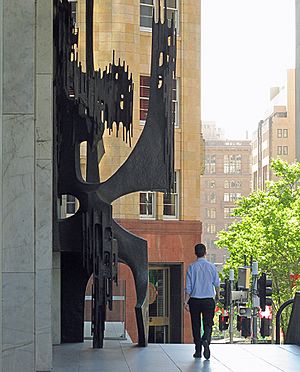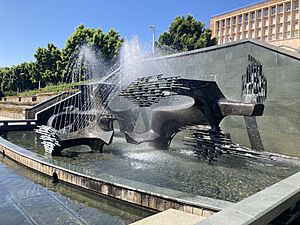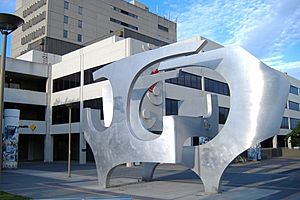Margel Hinder facts for kids
Margel Hinder (born January 4, 1906, in Brooklyn, New York – died May 29, 1995, in Roseville, New South Wales) was an important Australian-American sculptor. She was known for her modern art, especially her kinetic (moving) sculptures and large public artworks. You can see her sculptures outside the Reserve Bank of Australia building in Sydney, in a memorial in Newcastle, New South Wales, and in Canberra. Many of her artworks are kept in public art collections across Australia.
Contents
About Margel Hinder
Margel Hinder was born Margel Ina Harris in New York. Her parents were Wilson Park Harris and Helen Haist. Her father worked in a steel factory and later became a photographer. Margel went to art schools in the United States. She took children's art classes at the Albright Art School in Buffalo, New York. She also studied at the Boston Museum School in Boston.
Early Art Career
By May 1935, Margel Hinder was already showing her art in Sydney. She exhibited with the Women's Industrial Art Society. In 1938, she showed carved wooden bookends shaped like koala bears. The next year, she exhibited her sculptures at the David Jones Gallery in Sydney. An art writer from the Sydney Morning Herald newspaper mentioned her "unusual blocky carving of two doves."
In 1939, Margel and her husband, Frank Hinder, won a competition. They designed a figure for a new building in Sydney for the Water Board of NSW. Frank did the drawings, and Margel made a small plaster model called a maquette. Margel preferred carving in wood, but it was hard to find wood that was strong enough. She solved this by getting wood from a plantation in Papua New Guinea.
Margel Hinder was very interested in cubist constructivist art. This style was influenced by Eleonore Lange, an artist from Germany. Lange arrived in Australia in 1930. She was one of the few artists in Sydney interested in modern art during the 1930s. Lange organized an important show called Exhibition 1 in Sydney in 1939. This show featured artists, including Hinder, who liked semi-abstract painting and sculpture.
During World War II, Margel and her family moved to Canberra. There, she started to use steel in her sculptures.
Major Artworks and Achievements
After the war, Margel Hinder moved back to Sydney. She joined a group art show at the David Jones Gallery. She showed abstract art alongside other artists like Ralph Balson and Grace Crowley. The next year, she exhibited glass and plastic shapes. These works explored ideas about time and space. In an interview, she talked about balancing her family life with teaching at a college. She also gave lectures at the Art Gallery of NSW.
An art critic from the Sydney Morning Herald felt that sculpture was not as popular as painting. But they still reviewed her works carefully. They mentioned her sandstone "Garden Sculpture." This artwork was the first abstract sculpture bought by the Art Gallery of New South Wales. Around this time, Margel Hinder was also featured in the Australian Women's Day magazine. She began exploring rounded wire shapes, which she would use in her art for many years.
In 1953, one of Hinder's sculptures was chosen for a big international competition. The theme was The Unknown Political Prisoner. Her artwork was based on hand movements and was designed to be placed in water. The reflections in the water were part of the artwork. Margel Hinder's work won a prize of 275 pounds. The prize was announced at the Tate Gallery in London. She told a journalist that she felt "abstract artists have a hard time in Australia." She thought their work was "neither liked nor understood."
Margel Hinder's large sculpture outside the Reserve Bank of Australia in Martin Place, Sydney, is very famous. She won an international competition in 1961 to create it. The sculpture is abstract and made from cast copper with a steel core. People had mixed feelings about it because it was hard to tell what it was. The first Governor of the Reserve Bank, Dr. H. C. Coombs, strongly supported her work. He even wrote a note to his staff to explain it. In the same year, she won the Blake Prize for religious art. She won for her sculpture of Christ on the Cross.
When the Monaro Mall was built in Canberra in 1963, Hinder was asked to create a large mobile sculpture. It was placed above the escalators in the middle of the mall. This artwork, called Revolving Sphere, was a motorized spinning sphere. It reflected light as it moved. The Monaro Mall was the first air-conditioned and enclosed shopping center in Australia. Two years later, Hinder organized a touring sculpture exhibition. It was called 'Recent Australian Sculpture'. This was a big moment because it was the first time a touring sculpture exhibition had been organized. It was shown at the Menzies Library at the Australian National University.
One of Hinder's most important works is the Captain James Cook Memorial Fountain. It is a water sculpture located in Civic Park in Newcastle, New South Wales. Completed in 1966, it is made from steel, copper, and granite.
In 1969, Hinder's large aluminum abstract sculpture, Sculptured Form, was chosen for the Woden Town Square in Canberra. This sculpture was part of the Comalco Invitation Award. Six sculptors were asked to create a sculpture for a public space. The artwork was meant to show how a natural Australian environment grows and changes into a city.
In 1973, Margel Hinder finished another large sculpture. This one was for the Telecommunications Building in Adelaide.
She was given the title of a Member of the Order of Australia in 1979 for her contributions to art.
Personal Life
Margel Hinder was married to another artist, Francis Critcheley Hinder, known as Frank Hinder. They got married in Wellesley, Massachusetts, in 1930. Margel arrived in Australia with her husband in late 1934. She became a well-known artist, often called a "sculptress." People described her as "tall, slim" and "attractive." She was also known for wearing "strikingly original clothes" and hats that she designed herself.
Margel and Frank Hinder often showed their art together in group exhibitions. They also had two special shows looking back at their careers. One was in 1973 at the Newcastle Regional Gallery. The other was in 1980 at the Art Gallery of NSW. A book about Frank and Margel Hinder was written by Renee Free.
Margel Hinder passed away on May 29, 1995, in Roseville, New South Wales.
Selected Works
- 1939 Man with jackhammer, National Gallery of Victoria in Melbourne
- 1949 Garden Sculpture, Art Gallery of New South Wales in Sydney
- 1970 Sculptured Form, Woden Town Square in Canberra
- 1973 Free-Standing Sculpture, Telecommunication Building in Adelaide




